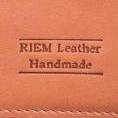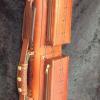-
Posts
505 -
Joined
-
Last visited
About JohnBarton
- Birthday 01/12/1968
Contact Methods
-
Website URL
http://www.jbcases.com
Profile Information
-
Gender
Male
-
Location
Earth
-
Interests
Playing pool, making cue cases, designing products, studying design, basically creating things - the more useful the better.
LW Info
-
Leatherwork Specialty
Billiard Cue Cases
-
Interested in learning about
Everything - mostly just interested in meeting great people
-
How did you find leatherworker.net?
researching methods of case making
JohnBarton's Achievements

Leatherworker (3/4)
-
Can always depend on Leather Worker.net members to have the right answer! Thank you.
-
These were finished up in 2012 but they are being delivered now. I am really happy with how they turned out. When we do these we never know how each piece of leather will take the colors so often we end up blending colors and that leads to some pretty cool uniquely colored cases. All of these are tooled across the seam on the back seam as well. All of these cases have laminated leather endcaps.
-

Stuff We Are Working On.
JohnBarton replied to JohnBarton's topic in Satchels, Luggage and Briefcases
Use good clean leather. We find a lot that lighter colors tend to highlight every flaw in the skin even when you can't see it before applying color. So now we buy ultra clean corrected grain which we use for the lighter stained pieces. Even then we sometimes will end up with blotchy pieces. When that happens someone else will be getting a black or dark brown case later. :-) Maybe some of the pros here have other tips. We generally will test on a scrap piece of the same leather before doing the whole piece. Sometimes that works and sometimes we still get funny spots. Other than that I don't have any advice but I will sure take any that I can get. -
As others have said your work never fails to amaze. It's not just that you make your own stamps but that you arrange them so intricately and blend the carving so seamlessly. Whenvever I see your work I think it could be 1000 years old and have been made by masters who deidcated their and their son's lives to the craft of working leather. Thank you for continuing to share and inspire.
-

Stuff We Are Working On.
JohnBarton replied to JohnBarton's topic in Satchels, Luggage and Briefcases
We get purple premixed from our supplier here and here we mixed in some blue to adjust the shade and thin it out with water. We generally do color samples for the customer until they are happy with the shade. I'd show you the bottle but it wouldn't do any good as it's packaged for China. Fwiw we use syringes to mix colors and try to write down our mixes so we can repeat them later. -
Thanks Michael, I should have read through the thread. You said it all right here.
-
It's not a loophole. Fair Use does not cover commercial works. It is 100% illegal to take a copyrighted image or a trademarked logo and use it commercially. Fair use is broad but it draws the line at reproduction and distribution. Fair use covers excerpting for commentary, use in satire, and personal reproduction as a backup. Even one-off items are infringing if the copyrighted/trademarked images are used. That's the law. Now will someone come after you? Probably not unless you get a lot of attention for your work. I will admit right here and now that I use images and trademarks in my work when people request it. I don't see any harm in putting the logo of a football team on a case other than I find it tacky personally. I am not selling the case as a Colts case and the way I see it is that it's not really much different if I tool the Colts logo on the case or the customer goes and buys a Colts patch and glues it to the case. I guess one could argue that the Colts get some small revenue from the sale of that patch somehow and not any from my use of it. Well, that's offset well enough by the lifetime of advertising my $500 leather case is providing them. I will take my chances on being contacted about it. Now we do agree that if I put up a page on my site with all the team logos and advertise I can and will do any "team" case that this is way over the line. Regarding replicas. There is no copyright on utilitarian items. The design on a leather bag is not copyrightable. It can only be protected under a design patent which specifically covers the decorative look and style. This costs money and time to get and is usually worthless to the small maker as there is not enough money to defend this patent when it's infringed. Nothing about a created piece is copyrightable unless it's non-utilitarian art. So no loophole is needed to create replicas of anything. The only exception to this is called trade dress which is a sort of copyright that exists when a company's products become known for a particular style. This area is however the slipperiest to establish and defend. This is also why the big brands in fashion bags put their logos all over the bags. This makes it impossible to replicate the bag without infringing on the trademark. However the bag itself can be duplicated without any trademarks and this is perfectly legal in the USA and most countries. Not all countries though, the law varies slightly throughout the world. That said on a general note copying is what has led us to where we are as a species. I mean individually we can be against it and I personally have lost millions in revenue to being copied. But the reality is that anything made that is useful or attractive is going to be copied. Biologically we are copies of our parents, socially we are copies of our societies norms. As makers most of us learned by copying the teacher's example. Innovation only happens through copying and tinkering with what has come before. So while it hurts us individually when we see our work copied in the grander scale we have contributed to the ongoing evolution of the species by making something worth copying. Each of us has to make our own decisions as to how far we will go when making things in using other people's ideas. Hopefully instead of just aping what others have done we tweak it and instill some new perspective. If not then at least we spread good ideas hopefully attached to quality work. I didn't go back and read the rest of the thread. Probably read it before but I am just rambling here......
-
Well I see this topic came back to life........got an email notice that there was a response. The topic title is comparison to other's work, the subtitle is 'how to do it without being a jerk', the shortest answer is probably that there is no way to do it without being a jerk. Meanwhile since I put the topic up Rusty Melton has truly become a master case maker. He builds a case now that takes no backseat to any other cue case maker ever in my opinion.
-
We have them made. In the absence of custom extrusion tubes like this you can bundle plumbing and electrical tubes to make the interior. Search my posts and you will find descriptions of the process.
-
Thank you everyone. It's a journey to teach people how to tool when I don't really know how to do it that well myself. I have a tiny talent for design and layout but I have to dig deep to bring it out. So I work with the apprentices to try to guide them and provide them with examples from the really talented toolers out there. I encourage them to explore and play with different ways to do things but to remember to pay attention to balance and flow. I hope we can get in to some really abstract stuff soon as well. That cannot really be taught but I hope by providing them with structure that they will get good at it and also bored with it enough to really let go and come with some radical stuff.
-
Most industrial die makers use AutoCad so you can send them .dxf files. In corel and probably in inkscape you can export or save as dxf and it should be fine. I always ask if I can send corel files as well for control purposes. Most of the time they also have corel. For that you can send the files as .cmx instead of .cdr and that will generally open up across versions.
-
A free and light vector drawing program is InkScape - you can find it via google easily. We use CorelDraw when we do patterns on the computer. You can find older versions of Corel for very little money that work perfectly fine for the needs of leatherworkers on Ebay. Look for Corel9, 10, 11, 12 and 13. I find that mocking up on paper is the trick here. We sample almost every part and element on paper and cardboard first and then in scrap leather before we commit to using the good stuff. With practice you can learn to print your patterns at exactly the right size you want. Sometimes you will need to print on two or more sheets and tape them together. Invest the time to learn to set up your printer's settings and learn and it will pay off hugely for those of you who would like to make your patterns on the computer. Lastly, try to avoid stretching your patterns if you want to change sizes. The computer is great for making patterns BUT you can get distorted easily if you start stretching the images you make. The way to do it in my opinion is to select the nodes and move them thus preserving proportions. This last bit is surely over the heads of those of you who have never used a drawing program to set up patterns. But as you get into it this will become clear. The beauty of using the computer is that you can change shapes and sizes easily. For example the credit card dividers that Reddevil shows can easily be changed to an almost infinite number of shapes and still retain function.
-
I am interested in purchasing your process if that's what you are selling. We are a small shop that does custom work and low volume production. I have been looking for a consistent and dependable solution to imprint images onto leather for a while. Or please send me some info on what exactly you are offering to jb@jbideas.com. Thanks, John Barton
-

The Production Of Sheridan Style Mural Process 2
JohnBarton replied to bobocat's topic in Floral and Sheridan Carving
Dylan, Bobocat is currently booking students for his Beijing classes. http://item.taobao.com/item.htm?id=17944604275 My wife and I just signed up to attend them. Be nice to see you there.






